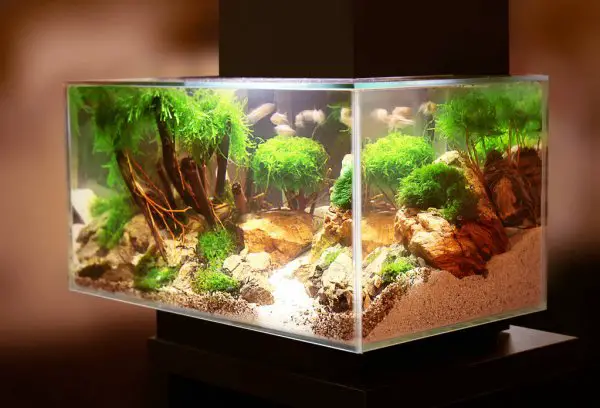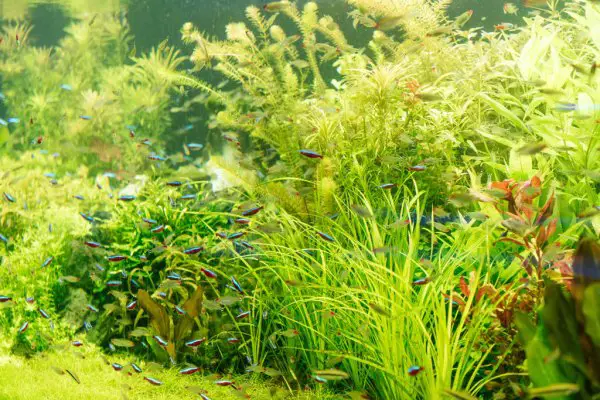The day is coming to a close, and the sun is starting to set outside. But should you follow the sun’s example and turn off your fish tank lights? Or leave aquarium lights running for longer periods of time?
One of the most common questions I get asked is, how long should I leave my aquarium light on?
The honest answer is: “it depends.”
But one should always keep the lights on a schedule that closely resembles a natural environment. This best meets the lighting needs of fish and plants. Let’s dive deeper into this question, shall we?
Live Plants and Aquarium Lights
While tropical fish are very flexible in how many hours of light you offer them, aquarium plants are much more demanding. 8 hours of light is a minimum for leaving the lights on, with 12 hours of light being better. As you likely know, plants need good lighting for proper photosynthesis during daylight hours, or they will wither and die.
Aquarium Lights and the Color Spectrum
Fluorescent and LED lights are ideal for planted aquariums because they run very cool and can be purchased in an ideal color spectrum. Lights produce specific wavelengths of color, but not all of them are useful for photosynthesis. Proper aquarium lighting for aquatic plants needs to have a color temperature of 6200-6800K.
Unfortunately, many stock aquarium lights have a color temperature that is either too warm (<6200K) or too cool (7000K+). Even if you turn the lights up to maximum power, the plants in your aquarium won’t grow well.

How Much Light Do My Specific Plants Need?
The type of plants in your aquarium will also affect how long you will want to leave the aquarium light running. Are you keeping carpeting plants? Floating plants? Something else? Each member of a planted tank community has differing needs.
Aquarists with carpeting aquatic plants should provide them with extra lighting, depending on how intense your light is. Floating plants are a little bit odd in that they love powerful aquarium lighting. But since they are floating right near the surface, they can make the most out of even aquarium lights of standard brightness.
Stem plants like Parrot’s Feather (Myriophyllum aquaticum) and Red Hygrophila (Alternanthera reineckii) are usually the most demanding since they are both light hungry and grow under the water’s surface. They need at least 10 hours of light per day for good growth.
If you are keeping low-light tropical plants like Anubias or Java Fern, then you don’t need to pay as much attention to the hours of light per day. These slow-growing plants will get by with the same amount of light that fish need.

Aquarium Lighting and Algae Issues
Algae growth is an unfortunate reality of owning a fish tank. Sooner or later, everyone has to scrape algae away from the glass. But knowing how aquarium light contributes to algae can make keeping it under control much easier!
Algae need not only light but nutrients to grow. And the more nutrients it has available, the heavier its growth will be. Aquariums with too many fish tend to grow heavier algae loads. In short, lowering the number of hours you leave the lights on, removing a few fish, feeding less, or performing more water changes can keep algae under control.
Algae and Ambient Light Sources
Another source of algae that might surprise you is ambient lighting from a nearby window. Ambient light is at the ideal spectrum that plants and algae need for photosynthesis.
Ambient lighting on top of what your hood is already outputting can be too much, resulting in heavy algae growth. Direct sunlight is even worse at causing algae issues.
If you’re having trouble with problem algae growth, you should reduce the hours a day your lighting fixture is running. And if ambient room lighting is also hitting the tank, I’d recommend either a solid background to block that light or moving the tank to stall the excess algae bloom.
Plants that float along the surface, like Red Root Floater (Phyllanthus fluitans) and those with large, floating leaves, like Red Tiger Lotus (Nymphaea Zenkeri), can also help control algae.
By physically blocking light from reaching it and absorbing extra nutrients when growing, these plants are highly effective at preventing algae issues caused by too much lighting!

How Many Hours of Light Per Day for Fish?
As we’ve established, tropical fish and plants have specific light needs. Interestingly enough, the recommended lighting guidelines for fish and aquatic plants are about the same: 8 to 12 hours of light per day!
10 hours is a happy medium in case you have scheduling and power concerns. Or if you aren’t keeping live plants at all, in which case you can use whatever color temperature or lighting intensity you want!
Plants may need different lighting in terms of color and intensity. But fish want the same hours of light to regulate their internal rhythms. Like us humans, fish have circadian rhythms controlled by natural light in nature and aquarium lights in a tank.
A sudden change in the amount of light is very stressful to fish because their bodies have been primed for slow shifts in seasons.
It’s similar to how out of balance you often feel when taking an international trip. The start, stop, and intensity of light disrupts your sleep patterns and leaves you feeling cranky and unmotivated for a few days until your circadian rhythm adjusts.
Lastly, don’t hesitate to provide subdued or even dim lighting for tanks with only fish. Many fish species, especially blackwater fish like Tetras and Angelfish, come from tannin-rich rivers that are tea-colored and extremely dim.
Low light levels help these fish species feel safe and more confident, which in turn encourages them to spend more time out in the open, swimming freely!
Do Aquarium Lights Raise the Water Temperature?
Generally no; when using typical fluorescent lights, you will see little to no increase in temperature. The output fluorescent lights provide is very efficient and transforms electricity into light with little waste.
And LED lighting is even better at creating light without heat. LED lights used to be extremely expensive; too much so for beginner aquarists. But nowadays, there are loads of high-quality LED aquarium lights available that are also very affordable.
But be sure to monitor the water temperature when running incandescent VHO fluorescent and metal halide lighting systems. These technologies are often used for marine reef tanks, professionally planted aquascapes, and other systems where intense light that resembles the sun is needed.
The high output of these types of lighting is incredible, but they also run very hot and can raise the water temperature if left on for too long.
But you’ll only ever run these aquarium lights for special use cases, like shallow-water coral reef aquascapes where you need to simulate the powerful equatorial sun using aquarium light!
What If I Am On Vacation?
If you have a trip coming up, what should one do about the tank lights? Simply leave them on all day with a vacation feeder?
No, as I mentioned earlier, leaving the lights on for extended periods is bad for fish health. Instead, I recommend picking up an automatic timer for your lights.
An automated timer can be set to turn the aquarium lighting on and off at a set time. This way, the tank won’t get too much light while you are away.
An automatic timer also helps regulate the system so your plants can become acclimated to a particular schedule. Plants have circadian rhythms just like fish and adjust their biochemistry to adapt to slow, seasonal rhythms, which light timers simulate!
Can I Leave My Aquarium Lights On All Night?
It is not a good idea to leave aquarium lights on all night. Fish of all kinds need to sleep, and light, even dim or blue light, disrupts their sleep schedule. Many light setups come with blue light bulbs and tell aquarists that you can leave the lights on all night to simulate moonlight using them.
Unfortunately, that’s not true and very bad for your fish. Firstly, the moonlight of a full moon isn’t available every night; it only happens every once in a while. Second, moonlight isn’t blue; it is reflected sunlight and therefore has a similar spectrum.
Nocturnal fish like knifefish and catfish also don’t need you to leave the light on for them. In fact, this will stress them greatly and prevent them from feeding at night as they normally do.
So leave the lights off at night, at least for 8 hours, if not longer!

Summary
Whether you are keeping plants or fish in your tank, the vast majority will find 8 to 12 hours a day of lighting to be perfect for their needs. But you will need to adjust the hours of aquarium light you offer if you have fish and plants that need more or less.
Generally, this is done to ensure lighting hungry plants like carpeting and stem plants get as much light as they can.
But remember that while plants crave light, there is such a thing as too much lighting. Leaving the lights running for too long will encourage heavy algae growth, especially in tanks with heavy fish populations or excess nutrients.
And ambient light can also cause issues in a tank near a window lit by the sun.
Lastly, never leave the lights running for so long that your fish don’t get enough sleep. All fish sleep, even nocturnal species. And without a good night’s sleep, they won’t be able to recuperate from the day’s activities or fight off disease normally.
FAQs:

